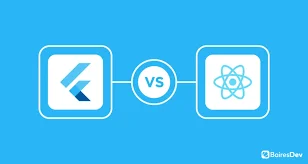React Native vs Flutter: Which to Choose for Cross-Platform App Development
Introduction
In today's mobile-first world, businesses increasingly rely on cross-platform app development to reach both Android and iOS users with a single codebase. Among the many frameworks available, React Native and Flutter stand out as two of the most popular and powerful options.
Both frameworks aim to simplify development, reduce costs, and accelerate time-to-market. But which one should you choose for your next mobile app project?
In this comprehensive comparison, we explore everything you need to know about React Native vs Flutter, including performance, UI components, community support, development experience, and suitability for different use cases.
1. What is React Native?
React Native, developed by Facebook, is an open-source framework that allows developers to build mobile applications using JavaScript and React. it enables code reuse across platforms while still delivering native-like performance.
React Native compiles JavaScript code into native components, allowing smooth integration with native APIs and tools. It is widely used by developers familiar with React for web development.
Key Highlights:
-
Language: JavaScript
-
Backed by: Meta (formerly Facebook)
-
Rendering: Native components
-
Ideal for: Fast prototyping, MVPs, and apps with simpler UIs
2. What is Flutter?
Flutter, developed by Google, is a modern open-source UI toolkit for building natively compiled applications for mobile, web, and desktop using a single codebase. It uses Dart, a language also developed by Google.
Flutter is known for its high performance, expressive UI, and customizable widgets that offer a consistent experience across all platforms.
Key Highlights:
-
Language: Dart
-
Backed by: Google
-
Rendering: Skia rendering engine (draws UI directly)
4. Performance Comparison
React Native
React Native bridges JavaScript and native code using a “bridge” mechanism, which can sometimes cause performance bottlenecks, especially in animation-heavy applications or those needing frequent communication between JavaScript and native modules.
That said, most standard applications perform well using React Native, especially when properly optimized.
Flutter
Flutter renders its own UI using the Skia engine, completely bypassing native components. This approach results in superior performance, particularly in animation-rich or graphics-intensive apps.
Conclusion on Performance:
If you are building a performance-sensitive application (e.g., games, AR/VR apps, complex animations), Flutter may have the edge. React Native works well for general-purpose apps.
5. UI and Design Capabilities
React Native
React Native uses native components for rendering UI. This ensures the app looks and feels native on both iOS and Android. However, platform-specific styling and component behavior may require conditional coding.
To achieve a highly customized UI, developers may need to rely on third-party libraries or create native modules.
Flutter
Flutter provides a vast collection of highly customizable widgets. Its “everything is a widget” philosophy allows for full control over every pixel, enabling beautiful, consistent, and dynamic UIs across platforms.
Flutter also includes pre-built widgets for both Material Design (Android) and Cupertino (iOS), simplifying platform-specific designs.
Conclusion on UI:
Flutter is more flexible and powerful for designing custom or complex UIs. React Native is better suited for apps that rely on a native look and feel.
6. Development Time and Learning Curve
React Native
Developers already familiar with JavaScript and React will find React Native easy to pick up. The large ecosystem and mature tooling also accelerate development time.
React Native’s hot reload and extensive community packages reduce the effort needed to create functional applications quickly.
Flutter
Flutter’s Dart language may pose a learning curve for developers coming from JavaScript or other backgrounds. However, once the basics are mastered, the framework allows for rapid development with clean and maintainable code.
Flutter's documentation is considered among the best in the industry, making onboarding easier.
Conclusion on Learning Curve:
React Native has a shallower learning curve for most developers. Flutter requires learning Dart but offers greater long-term productivity for some projects.
7. Ecosystem and Community Support
React Native
React Native has been around longer and boasts a large community of developers, contributors, and third-party libraries. Popular platforms like Expo further simplify development and deployment.
The large talent pool means hiring
React Native developers is generally easier.
Flutter
Flutter's community is younger but growing rapidly. Google’s ongoing investment in Flutter, along with support for web and desktop, is expanding its reach and toolset. Pub.dev provides thousands of Dart packages to enhance Flutter development.
Conclusion on Ecosystem:
React Native still leads in terms of community size and mature ecosystem. Flutter is catching up quickly with strong momentum.
8. Popular Apps Built with React Native and Flutter
React Native Apps:
-
Facebook
-
Instagram
-
Skype
-
Airbnb (legacy)
-
Bloomberg
-
Walmart
Flutter Apps:
-
Google Ads
-
Alibaba
-
eBay Motors
-
BMW
-
Reflectly
-
Nubank
These examples show that both frameworks are capable of powering apps at scale used by millions of users worldwide.
9. Which One Should You Choose?
Choose React Native if:
-
Your team is already experienced in JavaScript/React.
-
You want fast development with a large plugin ecosystem.
-
You’re building an MVP or need rapid prototyping.
-
Native look and feel is a priority.
Choose Flutter if:
-
You want full control over the UI and custom design.
-
You’re targeting multiple platforms, including desktop and web.
-
Performance and animation are critical.
-
You’re starting fresh and can learn Dart.
Ultimately, both frameworks are excellent choices. The best fit depends on your team’s expertise, your app’s goals, performance needs, and how much control you want over design and rendering.
10. Conclusion
Both React Native and Flutter are powerful frameworks that simplify cross-platform app development. React Native offers faster onboarding for web developers and a more native experience, while Flutter shines with custom UIs and high performance.
The decision between React Native vs Flutter should be based on your project’s specific needs, your team’s strengths, and your long-term goals.
No framework is universally better. Instead, focus on what aligns best with your app’s requirements.
Frequently Asked Questions (FAQs)
1. Is React Native better than Flutter?
It depends on the project. React Native is better for quick MVPs or if you have a team familiar with JavaScript. Flutter is better for custom UI and performance.
2. Can Flutter apps run on web and desktop too?
Yes. Flutter supports mobile, web, and desktop platforms from a single codebase, making it a true multi-platform framework.
3. Which is easier to learn: React Native or Flutter?
React Native is easier if you're already familiar with JavaScript. Flutter requires learning Dart, which may take time but is well-documented.
4. Are there any limitations to React Native?
React Native may face performance issues in graphics-heavy apps and may require native code for complex features.
5. Can both frameworks access native device features?
Yes. Both Flutter and React Native can access native APIs through platform channels or third-party plugins.







